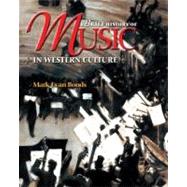
Mark Evan Bonds teaches music history at the University of North Carolina at Chapel Hill. He holds degrees from Duke University (B.A.), Christian-Albrechts-Universitat Kiel (M.A.), and Harvard University (Ph.D.). His publications include Wordless Rhetoric: Musical Form and the Metaphor of the Oration (1991), After Beethoven: Imperatives of Symphonic Originality (1996), and A History of Music in Western Culture (2003). He has also edited Beethoven Forum and written numerous essays on the music of Haydn and Mozart.
| Prologue: Antiquity | |
| Music in the Biblical World | |
| Ancient Greece | |
| Music in the Roman Empire | |
| The Musical Legacies of Antiquity | |
| The Medieval Era | |
| Prelude to Part I | |
| Plainchant and Secular Monophony | |
| The Emergence of Plainchant | |
| The Elements of Plainchant | |
| The Expansion of Plainchant | |
| Secular Monophony | |
| Polyphony to 1300 | |
| Organum | |
| Clausula | |
| Motet | |
| Conductus | |
| Mensural Notation | |
| Music in the 14th Century | |
| France: The Ars Nova | |
| Italy: The Trecento | |
| England | |
| Instrumental Music | |
| Music of the Renaissance | |
| Prelude to Part II | |
| Renaissance Humanism | |
| The Protestant Reformation | |
| Renaissance Painting and Sculpture | |
| Music in Renaissance Society | |
| The Emergence of Renaissance Style | |
| Consonance and Dissonance: Trusting the Ear | |
| Sonority: The Contenance Angloise | |
| Texture: Pervading Imitation | |
| Josquin's Ave Maria...virgo serena and the Style of the Renaissance | |
| The Genres of Renaissance Music, 1420-1520 | |
| Sacred Vocal Music | |
| Secular Vocal Music | |
| Instrumental Music | |
| Music in the 16th Century | |
| Secular Vocal Music | |
| Sacred Vocal Music | |
| Instrumental Music in the 16th Century | |
| Mannerism | |
| The Baroque Era | |
| Prelude to Part III | |
| War, Revolution, and Colonial Expansion | |
| The Scientific Revolution | |
| The Musical Baroque | |
| The New Practice | |
| Searching for the Secrets of Ancient Greek Music | |
| The Florentine Camerata | |
| The Seconda Prattica | |
| Music in the Baroque Era: A Stylistic Overview | |
| Vocal Music, 1600-1650 | |
| Secular Song | |
| Opera | |
| Sacred Music | |
| Vocal Music, 1600-1750 | |
| Opera | |
| Sacred Music | |
| Conceptions of the Compositional Process | |
| Instrumental Music, 1650-1750 | |
| Instruments of the Baroque Era | |
| Instrumental Genres of the Baroque Era | |
| The Classical Era | |
| Prelude to Part IV | |
| The Age of Enlightenment | |
| War and Revolution | |
| The Industrial Revolution | |
| Music in Enlightenment Society | |
| The Art of the Natural | |
| Music and the Idea of Nature | |
| Music in the Classical Era: A Stylistic Overview | |
| Style and Form in the Mid-18th Century | |
| Instrumental Music in the Classical Era | |
| The Language of Instrumental Music | |
| Sonata | |
| String Quartet | |
| Cyclical Coherence | |
| The Symphony | |
| Concerto | |
| Vocal Music in the Classical Era | |
| The Rise of Opera Buffa | |
| Opera Wars | |
| Gluck and the Reform of Opera | |
| Mozart and the Synthesis of Operatic Styles | |
| Sacred Music | |
| Song | |
| The 19th Century | |
| Prelude to Part V | |
| Progres | |
| Table of Contents provided by Publisher. All Rights Reserved. |
The New copy of this book will include any supplemental materials advertised. Please check the title of the book to determine if it should include any access cards, study guides, lab manuals, CDs, etc.
The Used, Rental and eBook copies of this book are not guaranteed to include any supplemental materials. Typically, only the book itself is included. This is true even if the title states it includes any access cards, study guides, lab manuals, CDs, etc.